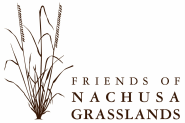Stop 1 — Open Woodland
How is an open woodland different from a forest or savanna?
LOOK UP AT THE TREE CANOPY. The open woodland canopy will cover 50%-80%, which is more shade than a savanna, but less shade than a forest. Established oak trees need sunlight on their limbs and leaves or they will die back, while oak seedlings need sunlight or they will not grow. Historically, fire and grazing kept the plant communities diverse and open. However, now controlled burns maintain these light gaps in the canopy and keep the understory less shrubby so the flowers and grasses can thrive.
Look at the trees found in this healthy open woodland. Woodlands can contain very distinctive or diverse species. This woodland happens to be the home to many nut–bearing trees like the white oak, red oak, bur oak and shagbark hickory. Some hackberry trees may also be seen.
Can you spot the differences between white oak, northern red oak, bur oak and shagbark hickory?
Stop 2 — Oak Savanna
Back to Tour Page
LOOK UP AT THE TREE CANOPY. The open woodland canopy will cover 50%-80%, which is more shade than a savanna, but less shade than a forest. Established oak trees need sunlight on their limbs and leaves or they will die back, while oak seedlings need sunlight or they will not grow. Historically, fire and grazing kept the plant communities diverse and open. However, now controlled burns maintain these light gaps in the canopy and keep the understory less shrubby so the flowers and grasses can thrive.
Look at the trees found in this healthy open woodland. Woodlands can contain very distinctive or diverse species. This woodland happens to be the home to many nut–bearing trees like the white oak, red oak, bur oak and shagbark hickory. Some hackberry trees may also be seen.
Can you spot the differences between white oak, northern red oak, bur oak and shagbark hickory?
- WHITE OAK has pale bark with flattish light patches. The leaves are evenly lobed and rounded at the tips.
- NORTHERN RED OAK has dark bark with long flat strips running vertically along the upper trunk and main branches (the strips look like ski tracks). The leaves have pointed lobes with a hair–like tip.
- BUR OAK has thick, fire–resistant bark, with very corky bark on the branches. The leaves have a wide upper part above a deep sinus, and rounded lobe ends.
- SHAGBARK HICKORY has long peeling strips of bark between very smooth bark. The branches are very thick and these trees have large buds.
Stop 2 — Oak Savanna
Back to Tour Page
LOOK FOR THIS 'NEAR THREATENED' WOODLAND BIRD. If you look and listen, you will likely discover the red–headed woodpecker. This woodpecker specifically seeks snags (dead or dying trees) found in open woodlands and oak savanna habitats to form its cavity nests. The controlled burns at Nachusa continually help create new snags for these birds. The bird experts fear that unless the Midwestern woodlands are managed for oak regeneration and open structure, the red–headed woodpecker is likely to become extinct. Luckily, here, these woodpeckers have rebounded in great numbers!
